Best Practices in HRM of Java Corp
VerifiedAdded on 2022/11/03
|6
|1300
|327
AI Summary
Read about the best practices in HRM of Java Corp to retain, empower and motivate employees to achieve the common goals of the organization. Find solutions to reduce costly employee turnover and improve employee engagement.
Contribute Materials
Your contribution can guide someone’s learning journey. Share your
documents today.
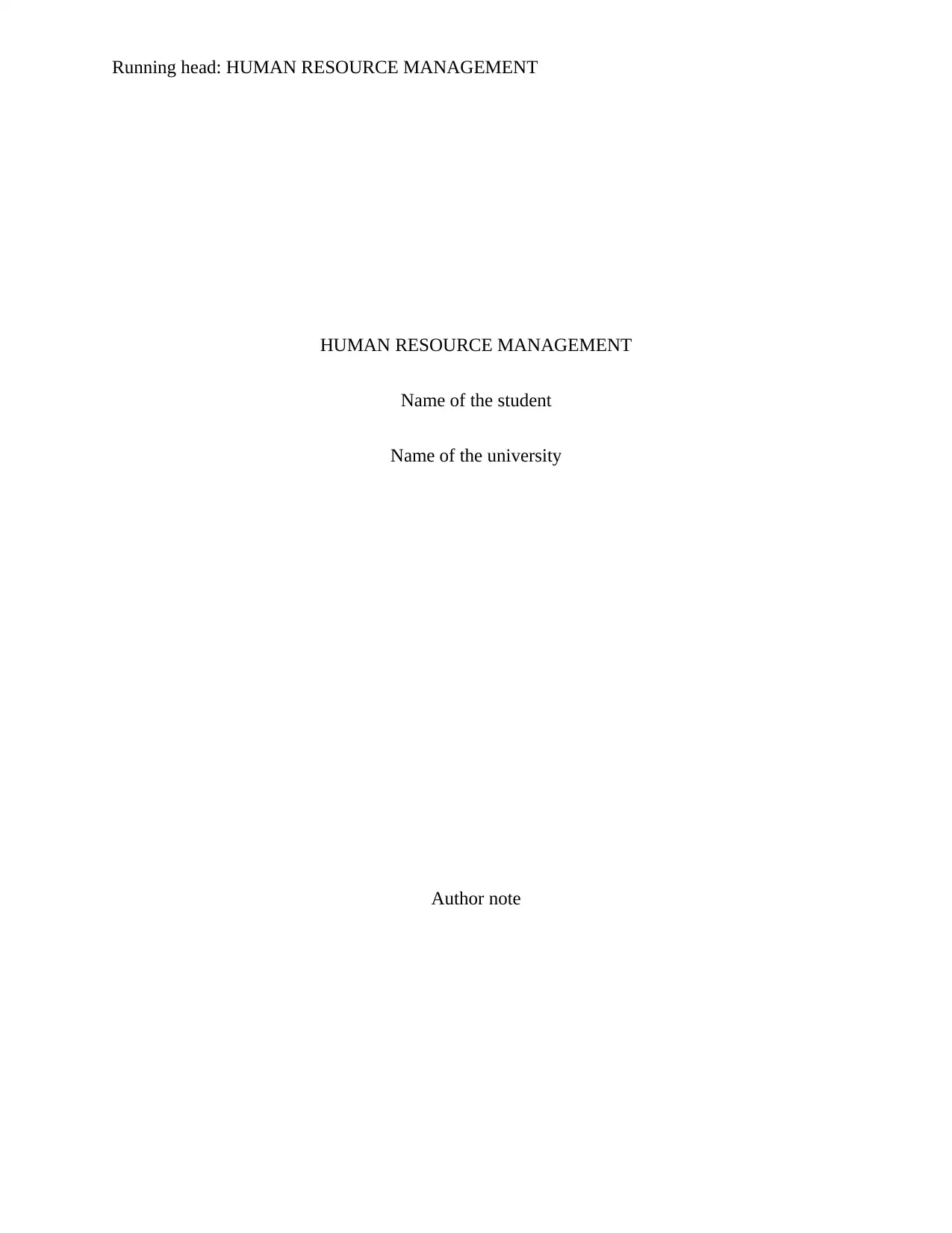
Running head: HUMAN RESOURCE MANAGEMENT
HUMAN RESOURCE MANAGEMENT
Name of the student
Name of the university
Author note
HUMAN RESOURCE MANAGEMENT
Name of the student
Name of the university
Author note
Secure Best Marks with AI Grader
Need help grading? Try our AI Grader for instant feedback on your assignments.
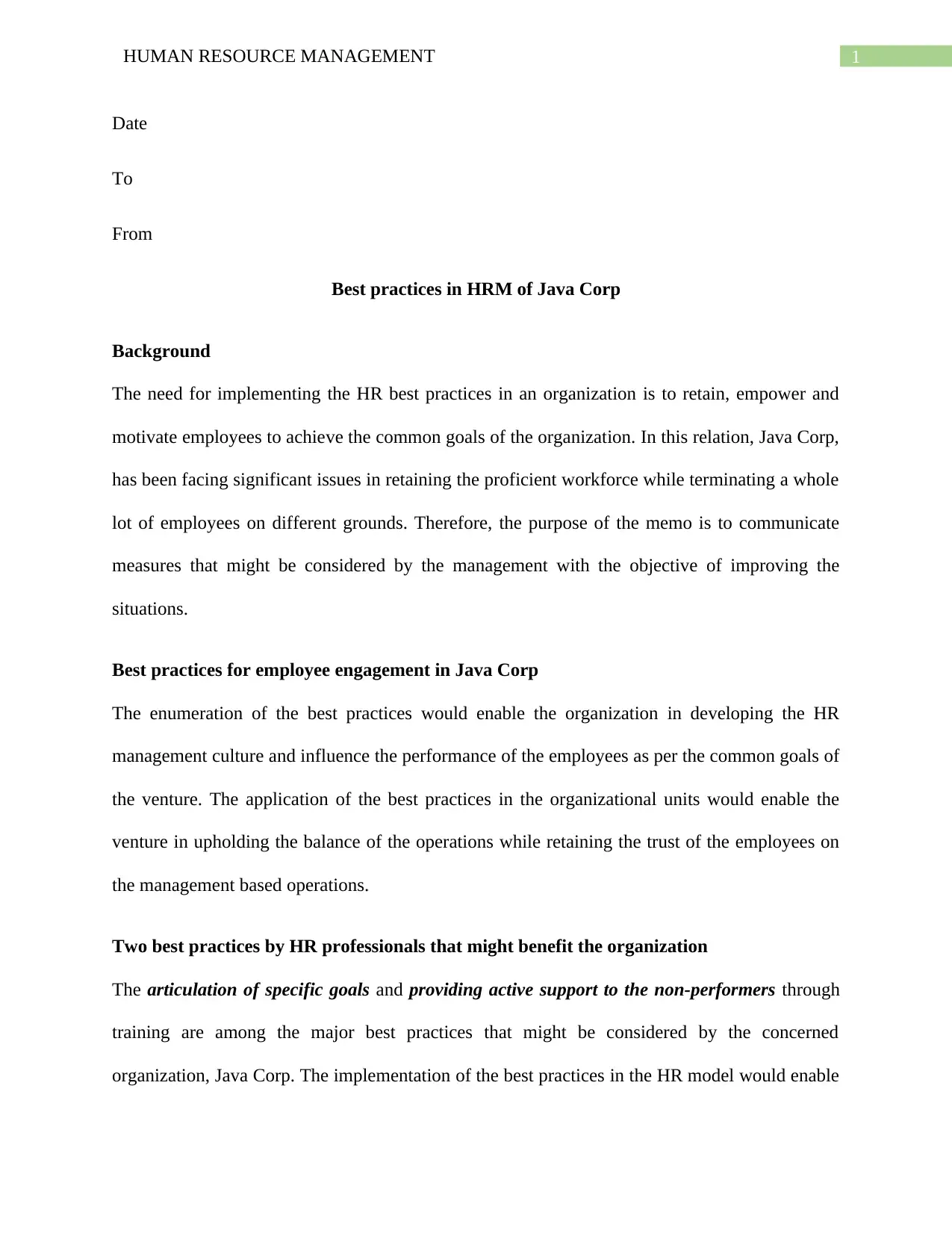
1HUMAN RESOURCE MANAGEMENT
Date
To
From
Best practices in HRM of Java Corp
Background
The need for implementing the HR best practices in an organization is to retain, empower and
motivate employees to achieve the common goals of the organization. In this relation, Java Corp,
has been facing significant issues in retaining the proficient workforce while terminating a whole
lot of employees on different grounds. Therefore, the purpose of the memo is to communicate
measures that might be considered by the management with the objective of improving the
situations.
Best practices for employee engagement in Java Corp
The enumeration of the best practices would enable the organization in developing the HR
management culture and influence the performance of the employees as per the common goals of
the venture. The application of the best practices in the organizational units would enable the
venture in upholding the balance of the operations while retaining the trust of the employees on
the management based operations.
Two best practices by HR professionals that might benefit the organization
The articulation of specific goals and providing active support to the non-performers through
training are among the major best practices that might be considered by the concerned
organization, Java Corp. The implementation of the best practices in the HR model would enable
Date
To
From
Best practices in HRM of Java Corp
Background
The need for implementing the HR best practices in an organization is to retain, empower and
motivate employees to achieve the common goals of the organization. In this relation, Java Corp,
has been facing significant issues in retaining the proficient workforce while terminating a whole
lot of employees on different grounds. Therefore, the purpose of the memo is to communicate
measures that might be considered by the management with the objective of improving the
situations.
Best practices for employee engagement in Java Corp
The enumeration of the best practices would enable the organization in developing the HR
management culture and influence the performance of the employees as per the common goals of
the venture. The application of the best practices in the organizational units would enable the
venture in upholding the balance of the operations while retaining the trust of the employees on
the management based operations.
Two best practices by HR professionals that might benefit the organization
The articulation of specific goals and providing active support to the non-performers through
training are among the major best practices that might be considered by the concerned
organization, Java Corp. The implementation of the best practices in the HR model would enable

2HUMAN RESOURCE MANAGEMENT
the venture in improving the structure of the operations while retaining the efficient employees
and improving the performance of the non-performers.
Retention strategies for Java Corp.
The concerned organization might take steps to induce training and development programs for
the on- performers rather than terminating them on the basis of their poor performance. On the
other hand, the organization might also take steps to introduce specific rewards and
remunerations systems in the organization like performance pays and recognition based
awarding on the contributions made by the employees. The modifications in the rewards and
remuneration along with providence of efficient training to the employees would enable the
organization in retaining the trust and loyalty of the employees towards the business goals.
Strategies that the organization can use to reduce costly employee turnover
The organization might hire the right people for the job positions through efficient screening
and interviewing. On the other hand, the planning an effective remuneration systems and the
flexible working schedules would enable the venture in retaining the loyalty of the employees
while supporting the same in minimizing the rate of staff turnovers in the business. The
application of the HR best practices, in this relation, would allow the venture in developing
efficient inter-trust factors among the employees and the managers. The key aspects of change in
the organizational operations are specifically based on the efficient functioning of the employees
while retaining the trust and loyalty of the employees.
Significance of voluntary and involuntary employee turnover
The delineation of the involuntary and voluntary employee turnover is important for the
organization with the objective of identifying the different issues in the organizational process
the venture in improving the structure of the operations while retaining the efficient employees
and improving the performance of the non-performers.
Retention strategies for Java Corp.
The concerned organization might take steps to induce training and development programs for
the on- performers rather than terminating them on the basis of their poor performance. On the
other hand, the organization might also take steps to introduce specific rewards and
remunerations systems in the organization like performance pays and recognition based
awarding on the contributions made by the employees. The modifications in the rewards and
remuneration along with providence of efficient training to the employees would enable the
organization in retaining the trust and loyalty of the employees towards the business goals.
Strategies that the organization can use to reduce costly employee turnover
The organization might hire the right people for the job positions through efficient screening
and interviewing. On the other hand, the planning an effective remuneration systems and the
flexible working schedules would enable the venture in retaining the loyalty of the employees
while supporting the same in minimizing the rate of staff turnovers in the business. The
application of the HR best practices, in this relation, would allow the venture in developing
efficient inter-trust factors among the employees and the managers. The key aspects of change in
the organizational operations are specifically based on the efficient functioning of the employees
while retaining the trust and loyalty of the employees.
Significance of voluntary and involuntary employee turnover
The delineation of the involuntary and voluntary employee turnover is important for the
organization with the objective of identifying the different issues in the organizational process
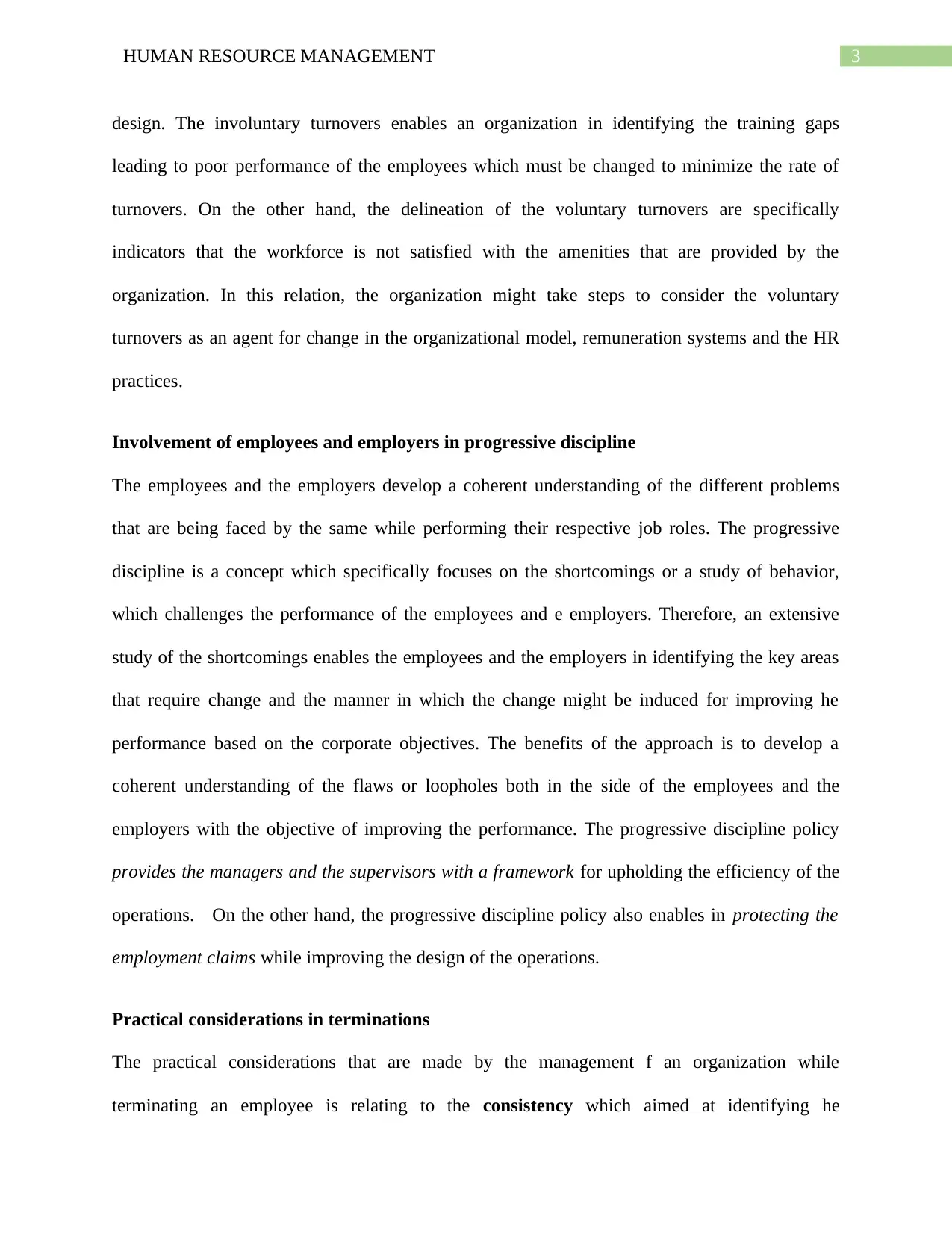
3HUMAN RESOURCE MANAGEMENT
design. The involuntary turnovers enables an organization in identifying the training gaps
leading to poor performance of the employees which must be changed to minimize the rate of
turnovers. On the other hand, the delineation of the voluntary turnovers are specifically
indicators that the workforce is not satisfied with the amenities that are provided by the
organization. In this relation, the organization might take steps to consider the voluntary
turnovers as an agent for change in the organizational model, remuneration systems and the HR
practices.
Involvement of employees and employers in progressive discipline
The employees and the employers develop a coherent understanding of the different problems
that are being faced by the same while performing their respective job roles. The progressive
discipline is a concept which specifically focuses on the shortcomings or a study of behavior,
which challenges the performance of the employees and e employers. Therefore, an extensive
study of the shortcomings enables the employees and the employers in identifying the key areas
that require change and the manner in which the change might be induced for improving he
performance based on the corporate objectives. The benefits of the approach is to develop a
coherent understanding of the flaws or loopholes both in the side of the employees and the
employers with the objective of improving the performance. The progressive discipline policy
provides the managers and the supervisors with a framework for upholding the efficiency of the
operations. On the other hand, the progressive discipline policy also enables in protecting the
employment claims while improving the design of the operations.
Practical considerations in terminations
The practical considerations that are made by the management f an organization while
terminating an employee is relating to the consistency which aimed at identifying he
design. The involuntary turnovers enables an organization in identifying the training gaps
leading to poor performance of the employees which must be changed to minimize the rate of
turnovers. On the other hand, the delineation of the voluntary turnovers are specifically
indicators that the workforce is not satisfied with the amenities that are provided by the
organization. In this relation, the organization might take steps to consider the voluntary
turnovers as an agent for change in the organizational model, remuneration systems and the HR
practices.
Involvement of employees and employers in progressive discipline
The employees and the employers develop a coherent understanding of the different problems
that are being faced by the same while performing their respective job roles. The progressive
discipline is a concept which specifically focuses on the shortcomings or a study of behavior,
which challenges the performance of the employees and e employers. Therefore, an extensive
study of the shortcomings enables the employees and the employers in identifying the key areas
that require change and the manner in which the change might be induced for improving he
performance based on the corporate objectives. The benefits of the approach is to develop a
coherent understanding of the flaws or loopholes both in the side of the employees and the
employers with the objective of improving the performance. The progressive discipline policy
provides the managers and the supervisors with a framework for upholding the efficiency of the
operations. On the other hand, the progressive discipline policy also enables in protecting the
employment claims while improving the design of the operations.
Practical considerations in terminations
The practical considerations that are made by the management f an organization while
terminating an employee is relating to the consistency which aimed at identifying he
Secure Best Marks with AI Grader
Need help grading? Try our AI Grader for instant feedback on your assignments.
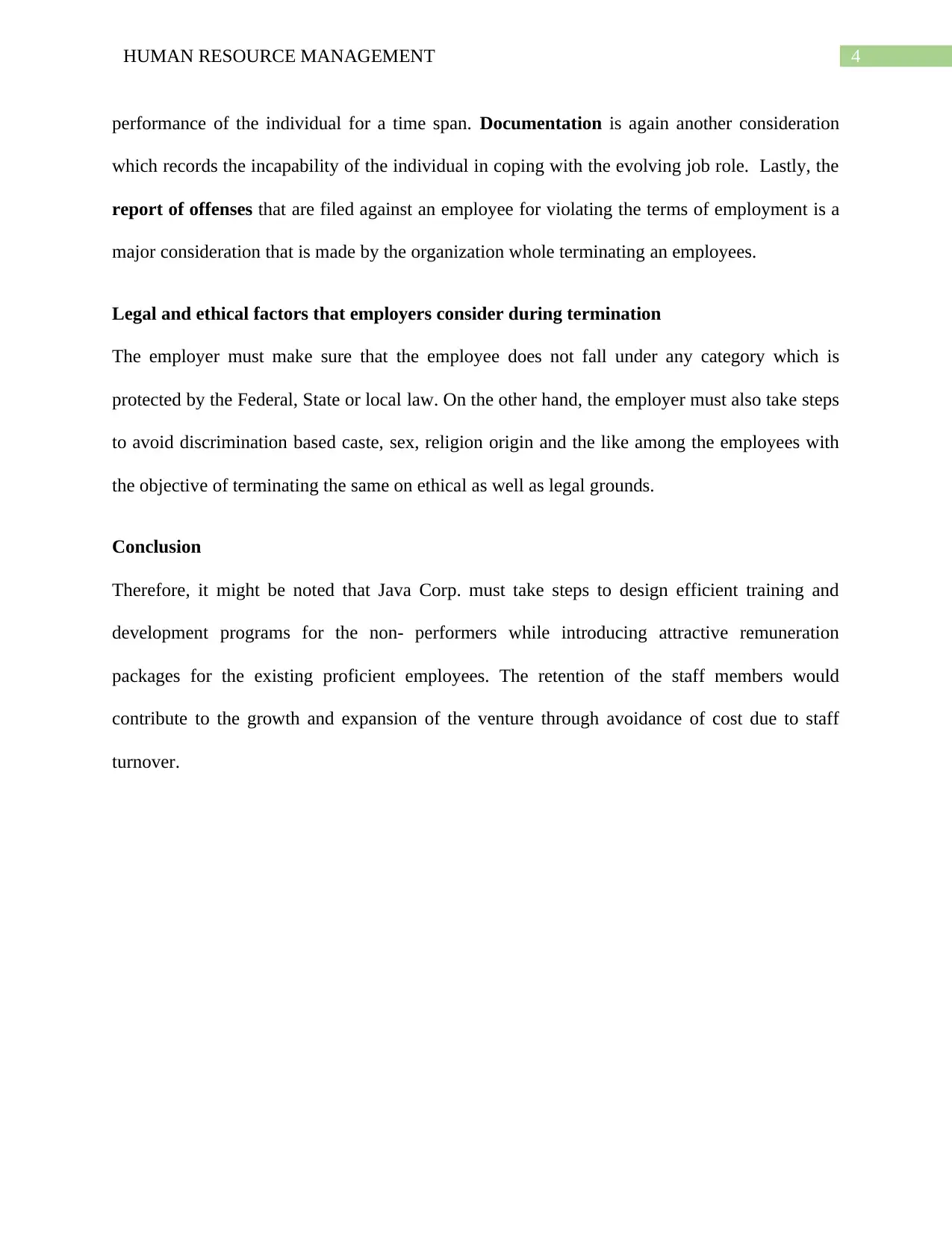
4HUMAN RESOURCE MANAGEMENT
performance of the individual for a time span. Documentation is again another consideration
which records the incapability of the individual in coping with the evolving job role. Lastly, the
report of offenses that are filed against an employee for violating the terms of employment is a
major consideration that is made by the organization whole terminating an employees.
Legal and ethical factors that employers consider during termination
The employer must make sure that the employee does not fall under any category which is
protected by the Federal, State or local law. On the other hand, the employer must also take steps
to avoid discrimination based caste, sex, religion origin and the like among the employees with
the objective of terminating the same on ethical as well as legal grounds.
Conclusion
Therefore, it might be noted that Java Corp. must take steps to design efficient training and
development programs for the non- performers while introducing attractive remuneration
packages for the existing proficient employees. The retention of the staff members would
contribute to the growth and expansion of the venture through avoidance of cost due to staff
turnover.
performance of the individual for a time span. Documentation is again another consideration
which records the incapability of the individual in coping with the evolving job role. Lastly, the
report of offenses that are filed against an employee for violating the terms of employment is a
major consideration that is made by the organization whole terminating an employees.
Legal and ethical factors that employers consider during termination
The employer must make sure that the employee does not fall under any category which is
protected by the Federal, State or local law. On the other hand, the employer must also take steps
to avoid discrimination based caste, sex, religion origin and the like among the employees with
the objective of terminating the same on ethical as well as legal grounds.
Conclusion
Therefore, it might be noted that Java Corp. must take steps to design efficient training and
development programs for the non- performers while introducing attractive remuneration
packages for the existing proficient employees. The retention of the staff members would
contribute to the growth and expansion of the venture through avoidance of cost due to staff
turnover.
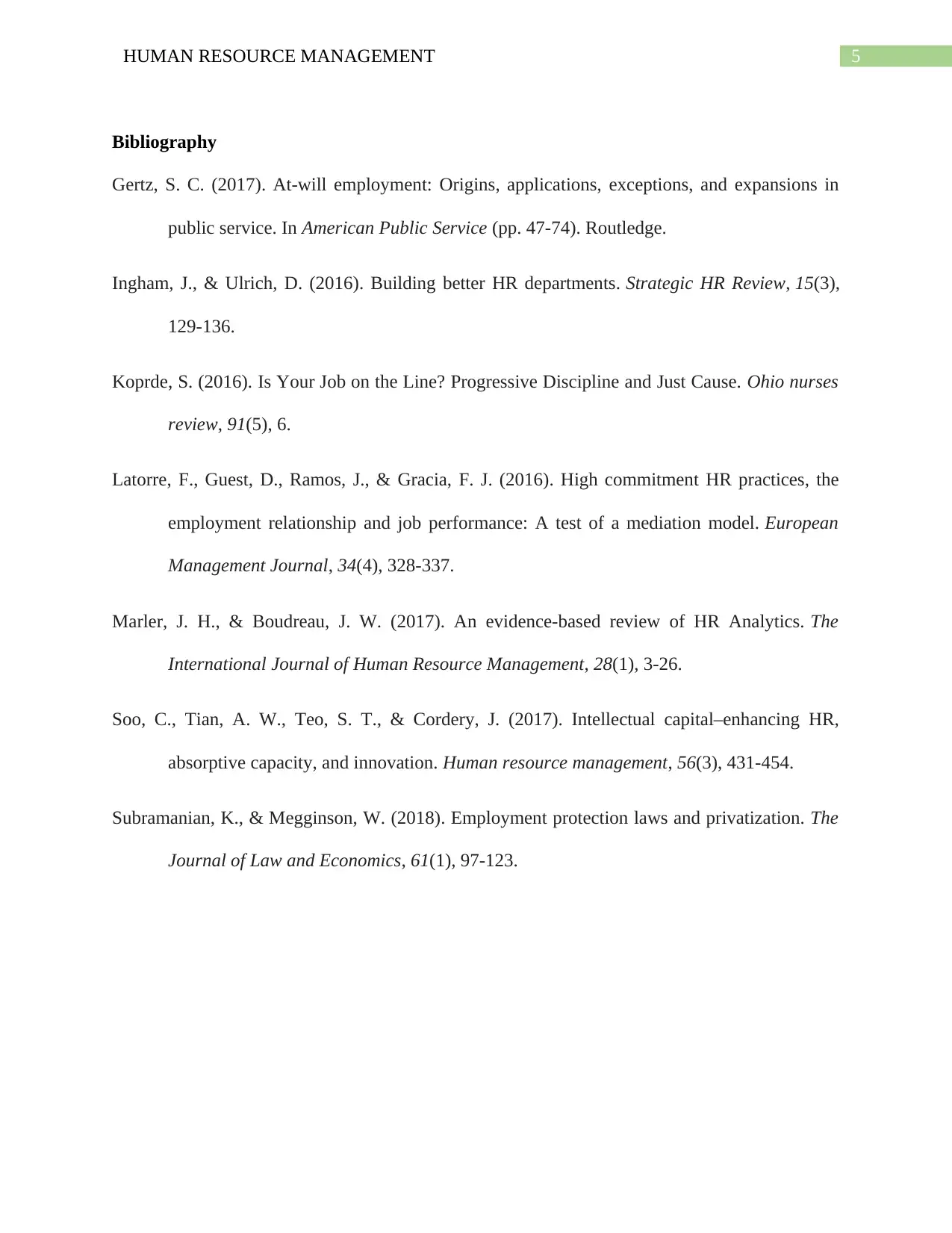
5HUMAN RESOURCE MANAGEMENT
Bibliography
Gertz, S. C. (2017). At-will employment: Origins, applications, exceptions, and expansions in
public service. In American Public Service (pp. 47-74). Routledge.
Ingham, J., & Ulrich, D. (2016). Building better HR departments. Strategic HR Review, 15(3),
129-136.
Koprde, S. (2016). Is Your Job on the Line? Progressive Discipline and Just Cause. Ohio nurses
review, 91(5), 6.
Latorre, F., Guest, D., Ramos, J., & Gracia, F. J. (2016). High commitment HR practices, the
employment relationship and job performance: A test of a mediation model. European
Management Journal, 34(4), 328-337.
Marler, J. H., & Boudreau, J. W. (2017). An evidence-based review of HR Analytics. The
International Journal of Human Resource Management, 28(1), 3-26.
Soo, C., Tian, A. W., Teo, S. T., & Cordery, J. (2017). Intellectual capital–enhancing HR,
absorptive capacity, and innovation. Human resource management, 56(3), 431-454.
Subramanian, K., & Megginson, W. (2018). Employment protection laws and privatization. The
Journal of Law and Economics, 61(1), 97-123.
Bibliography
Gertz, S. C. (2017). At-will employment: Origins, applications, exceptions, and expansions in
public service. In American Public Service (pp. 47-74). Routledge.
Ingham, J., & Ulrich, D. (2016). Building better HR departments. Strategic HR Review, 15(3),
129-136.
Koprde, S. (2016). Is Your Job on the Line? Progressive Discipline and Just Cause. Ohio nurses
review, 91(5), 6.
Latorre, F., Guest, D., Ramos, J., & Gracia, F. J. (2016). High commitment HR practices, the
employment relationship and job performance: A test of a mediation model. European
Management Journal, 34(4), 328-337.
Marler, J. H., & Boudreau, J. W. (2017). An evidence-based review of HR Analytics. The
International Journal of Human Resource Management, 28(1), 3-26.
Soo, C., Tian, A. W., Teo, S. T., & Cordery, J. (2017). Intellectual capital–enhancing HR,
absorptive capacity, and innovation. Human resource management, 56(3), 431-454.
Subramanian, K., & Megginson, W. (2018). Employment protection laws and privatization. The
Journal of Law and Economics, 61(1), 97-123.
1 out of 6
Related Documents
Your All-in-One AI-Powered Toolkit for Academic Success.
+13062052269
info@desklib.com
Available 24*7 on WhatsApp / Email
![[object Object]](/_next/static/media/star-bottom.7253800d.svg)
Unlock your academic potential
© 2024 | Zucol Services PVT LTD | All rights reserved.





